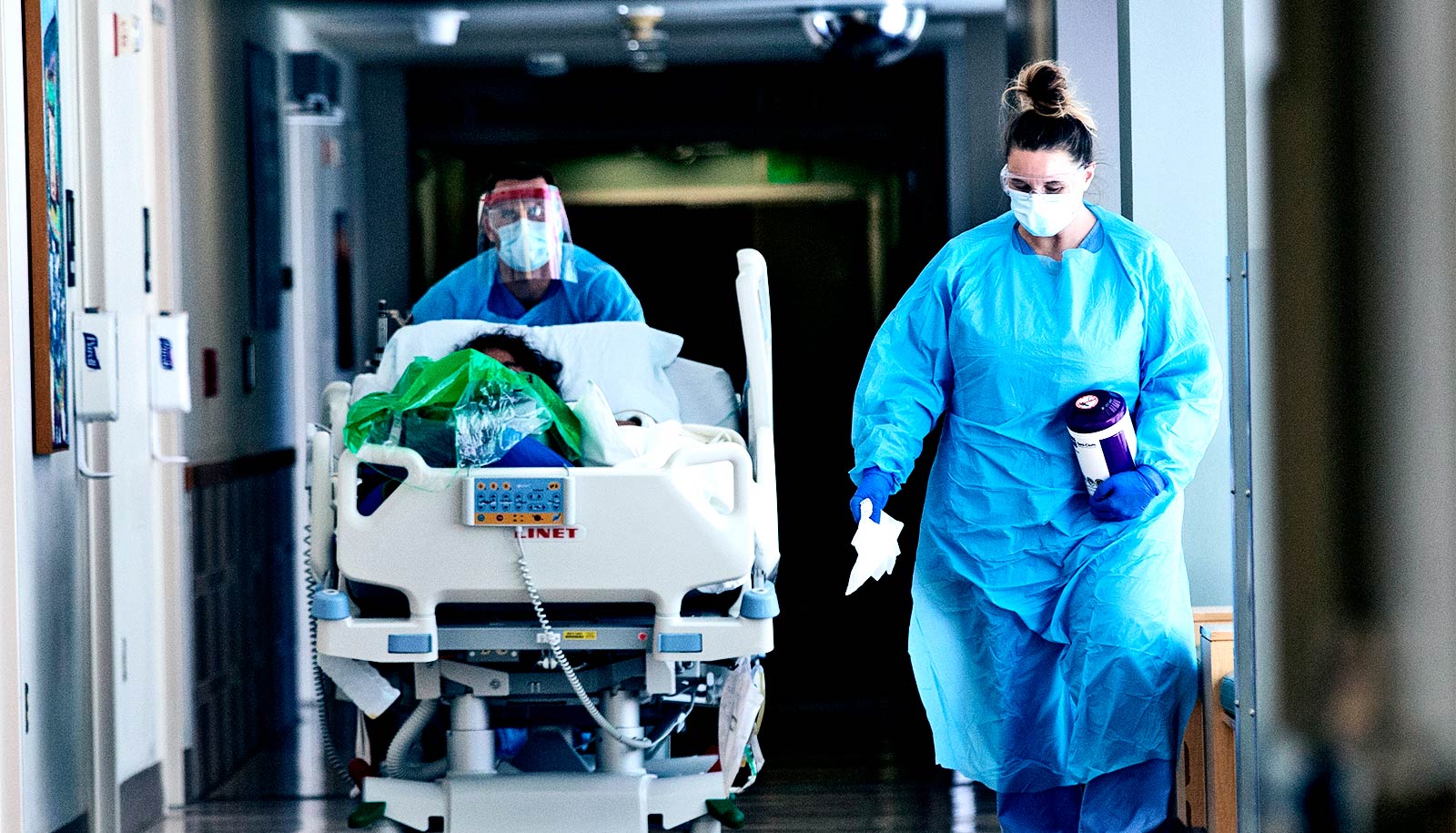
A nurse on infection control accompanies a patient being transferred from the ICU COVID unit to the acute care COVID unit at Harborview Medical Center on May 7, 2020 in Seattle, Washington. (Credit: Karen Ducey/Getty Images )
US COVID-19 patients have longer hospital stays than in China
COVID-19 hospitalizations in the United States are longer than in China and patients face higher rates of intensive care unit admission, research shows.
Hospitalized COVID-19 patients in the US stay in the hospital longer and face higher rates of intensive care unit admission than patients in China, according to a new study.
The results suggest that the coronavirus pandemic may hit hospitals in the US harder than initially thought, as many forecasts of disease burden—particularly the number of hospital beds and intensive care unit (ICU) beds needed at the peak of infection—are based on data out of China.
“The hospital resources needed to meet the needs of severely ill patients are substantial,” says lead author Joseph Lewnard, an assistant professor of epidemiology at the University of California, Berkeley. “We found that observations from China may not provide a sufficient basis for anticipating the US health care demand.”
The team analyzed the anonymized medical records of the nearly 9.6 million Kaiser Permanente members in Southern California, Northern California, and Washington state.
The study focused on 1,277 Kaiser Permanente members hospitalized with clinically- or laboratory-confirmed cases of COVID-19 between the start of the year and early April.
“Because Kaiser Permanente members receive comprehensive health care from a single provider network, we overcome many of the difficulties that arise in studies of diseases within the fragmented US health care delivery system,” says Lewnard.
Despite the grim forecast for hospitals, the report does offer a glimmer of hope: Estimates of transmission intensity, based on extrapolations of infection rates from hospitalization data, indicate that the social distancing measures in the region are succeeding at “flattening the curve” of contagion.
“When people engaged in protecting themselves and their communities through social distancing, their efforts translated into a substantial reduction in the transmissibility of the disease,” says coauthor Vincent Liu, a research scientist at the Kaiser Permanente Division of Research in Northern California.
“Those efforts are going to be critical for this next phase, in which social distancing measures are gradually relaxed. We need our communities to stay really engaged, because these data show that even the actions of individuals and small groups can really impact the spread of the virus.”
US COVID-19 hospitalization vs. global data
Of the 1,277 patients researchers studied who were hospitalized with COVID-19, 42% required care in the ICU, and 18% died from the disease. Modeling estimates based on observations in China usually assume that only about 30% of hospitalized patients will require ICU care.
Similarly, the data showed that hospital stays lasted an average of 10.7 days for survivors and 13.7 days for non-survivors, compared to an average of 7.5 days among non-survivors in China.
Troublingly, 25% of patients remained in the hospital for 16 days or more. In comparison, a widely-used modeling study from Imperial College London projecting health care needs assumes an average stay of eight days.
While the underlying reasons for these discrepancies remain unclear, the authors stress the need to collect data in different regions and under different health care settings and caution against heavy reliance on models based on data from other countries.
“The spread of COVID-19 and its impact on local health care systems show differences across the world,” Liu says. “Health care systems differ, and their capabilities and structure have an effect on the local response and the impact of the surge. So, it’s really important to understand how our own data agree with, or in some cases differ, from the experience we’ve seen in other countries.”
‘We have to be strategic and vigilant’
Not surprisingly, the analysis also revealed that the virus tends to hit older people the hardest. Approximately 50% of hospitalizations were among adults aged 60 and older, and 25% were among adults aged 73 and older.
Similarly, hospitalized men seemed to be hit harder than women: Hospitalized males over the age of 80 faced a 58% risk of death, and hospitalized females of the same age faced only a 32% risk of death .
Estimates of transmission intensity over time yielded promising results. The team found that the transmission rate of the virus has decreased significantly, and the drop began slightly before statewide shelter-in-place orders went into effect in late March. This effect is likely due to the implementation of smaller-scale social distancing measures, such as local restrictions on gatherings and individuals’ compliance with safety recommendations, in the weeks prior to the statewide orders, the authors says.
However, while the data indicate that social distancing is succeeding, the authors warn that we shouldn’t expect to return to normal anytime soon.
“These data suggest that if we were to release all of our mitigation measures at one time, the disease would start rapidly spreading again,” Liu says. “We have to be really strategic and vigilant about how and when we roll back our social distancing measures. It’s going to require coordination between health care systems, community partners, government and public health agencies, academic institutions, and industry.”
“We also need to be mindful of just how severe the disease is,” Lewnard adds. “We see an 18% overall fatality rate among all people who are getting hospitalized, and 42% end up in the ICU, so the impact of transmission in terms of severe disease and hospital burden is quite high.”
The results appear in the The BMJ . Additional coauthors are from Kaiser Permanente, Imperial College London, and UC Berkeley.
Kaiser Permanente funded the study.
Source: UC Berkeley
The post US COVID-19 patients have longer hospital stays than in China appeared first on Futurity .
Share this article:
This article uses material from the Futurity article, and is licenced under a CC BY-SA 4.0 International License. Images, videos and audio are available under their respective licenses.
Related Articles:
Turning off your camera can ease ‘Zoom fatigue’
Sept. 2, 2021 • futurityCOVID-19: Why you really can’t ‘visit just one friend’
April 14, 2020 • futurityLinks/images:
- https://www.futurity.org/china-first-50-days-covid-19-infections-2321582/
- https://www.futurity.org/out-of-pocket-covid-19-care-free-health-care-costs-2373132-2/
- https://www.futurity.org/covid-19-diagnosis-platform-nanoparticles-2369012/
- https://doi.org/10.1136/bmj.m1923
- https://news.berkeley.edu/2020/05/26/long-hospital-stays-high-rates-of-icu-admission-for-u-s-covid-19-patients/
- https://www.futurity.org/covid-19-patients-hospitalization-2374862-2/
- https://www.futurity.org


